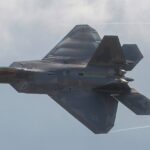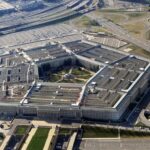By Jack Phillips
The United States will stop developing nuclear-armed, sea-launched cruise missiles, according to new documents released by the Department of Defense (DOD).
The documents (pdf), released Thursday, stated that the United States will “retire the B83-1 gravity bomb,” and will “cancel the nuclear-armed Sea-Launched Cruise Missile (SLCM-N) program.”
During a news conference, Defense Secretary Lloyd Austin faced questions about retiring the two programs, arguing that “our inventory of nuclear weapons is significant.”
“I do not believe this sends a message to Putin,” Austin told a reporter. “He understands what our capability is.”
The Biden administration released three documents on Thursday: the National Defense Strategy, Nuclear Posture Review, and Missile Defense Review. Together, they laid out the military’s priorities for the coming years and underscored that Washington would maintain “a very high bar for nuclear employment.”
Under President Donald Trump’s administration, the military made a decision in 2018 to develop a new nuclear-armed sea-launched cruise missile, with a focus on the threat from Russia.
But the Biden administration said in its review the sea-launched cruise missile program was unnecessary and would be canceled because the United States already had the “means to deter limited nuclear use.”
One program from the Trump administration that Biden is keeping is the W76-2 low-yield submarine-launched ballistic missile, which the Pentagon fielded in 2020 to address Russia’s potential employment of similar-scale tactical nuclear weapons, the kind that Moscow has threatened to use in Ukraine to salvage its war there.
‘Very High Bar’
The document also said that U.S. nuclear policy will maintain “a very high bar for nuclear employment,” but it would “only consider the use of nuclear weapons in extreme circumstances to defend the vital interests of the United States or its Allies and partners.”
“By the 2030s the United States will, for the first time in its history, face two major nuclear powers as strategic competitors and potential adversaries. This will create new stresses on stability and new challenges for deterrence, assurance, arms control, and risk reduction,” the document says.
In addressing the U.S. military’s strategy, Austin told reporters that Russia, unlike China, “cannot systemically challenge the United States in the long term,” but he said that Russian aggression currently poses “an immediate and sharp threat to our interests and values.”
The Chinese regime wants to employ 1,000 deliverable warheads by the end of the 2020s, according to the Pentagon document. The Chinese Communist Party, it added, could use those weapons for military provocations against U.S. allies in the region.
Despite Russian officials’ recent comments about using nuclear weapons to defend Russia, U.S. officials say they have not seen indications that Moscow is preparing to use them. It comes as Russian President Vladimir Putin on Wednesday observed exercises by Russia’s strategic nuclear forces, the Kremlin said.
Reuters contributed to this report.






